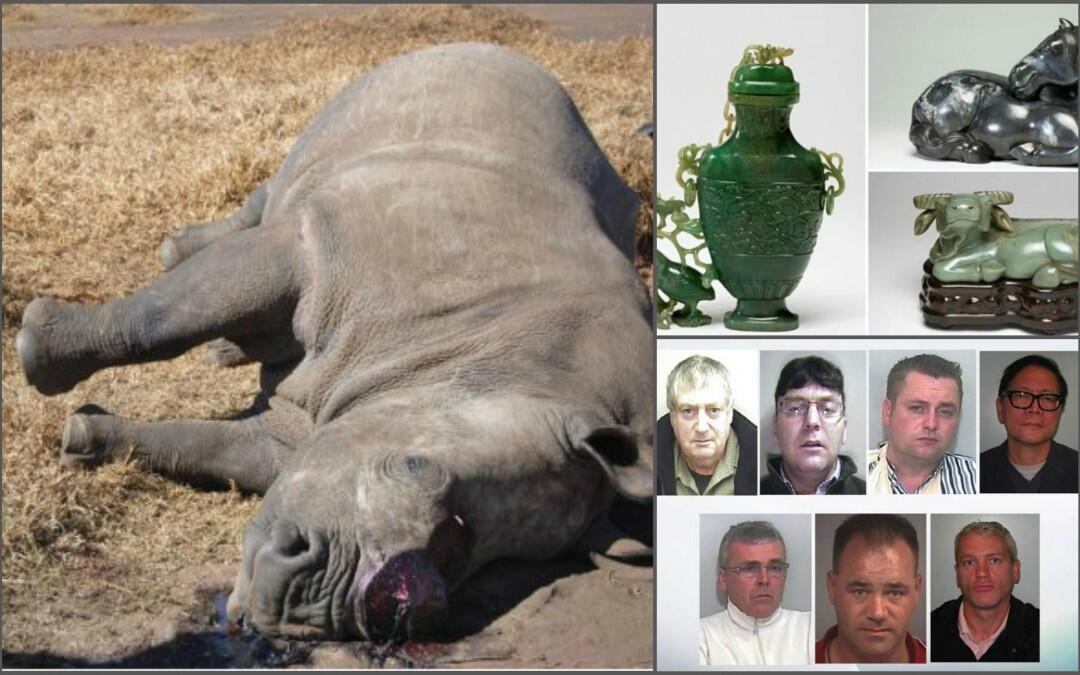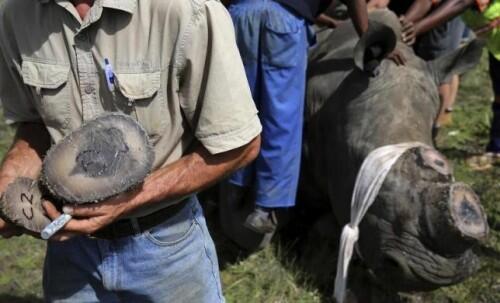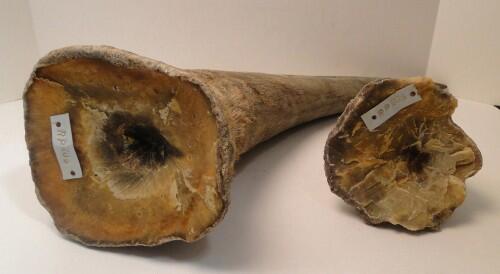Seven men have been jailed for a total of more than 37 years over a plot to steal Chinese artefacts worth up to £57 million from British museums. That gang was behind break-ins at Cambridge’s Fitzwilliam Museum and Durham’s Oriental Museum in 2012 and also tried to take a rhino head from Norwich Castle Museum. Many have been talking about the artefacts though. No one is mentioning the Rhino Head, or the wicked rhino poaching which kills that adorable animal brutally.
In total the group, made up of 14 men, plotted to steal 24 artefacts, with as many as 18 never recovered. The seven jailed today were behind the planning of the raids, while others actually carried them out.
Jurors at Birmingham Crown Court heard the stolen exhibits were valued at around £17 million but detectives believe they might have fetched £57 million in the “booming” Chinese auction market.
Who is that Gang?
The gang was dubbed the Rathkeale Rovers, as some of the men had connections to the Irish town. Judge Murray Creed jailed Richard “Kerry” O’Brien, 31, of Cambridgeshire – and also of Rathkeale – for five-and-a-half years.
His uncle, John “Cash” O’Brien, 68 and from Wolverhampton, was sentenced to five years and three months in prison. Daniel “Turkey” O’Brien, 45, and Daniel Flynn, also 45, both of Smithy Fen, Cottenham, Cambridgeshire, were jailed for six years and eight months and four years, respectively.
Donald Wong, 56, of Clapham Common South Side in London, who was described by the judge as “a buyer, seller and valuer”, was sentenced to five-and-a-half years. Paul Pammen, 49, of Southend-on-Sea, and 37-year-old Alan Clarke, of Newham, London, who was said to have headed the gang’s “disposal team”, were also both jailed for five-and-a-half years each.
Judge Creed said the criminal enterprise “involved very high value goods with significant harm caused to victims, both museums and members of the public who would otherwise have viewed the material stolen”.
He added: “It is a conspiracy both sophisticated, skilled and persistent, involved significant cultural loss to the UK of museum quality artefacts and items from international collections.”
Six convicted over the conspiracy will be sentenced on Tuesday. A 14th man had already been convicted and sentenced for his part in the crime, last year.
Brutal Rhino Poaching
In South Africa mostly, an adorable animal is being killed for various uses. The Rhino is a victim of Rhino poaching, which has escalated in recent years and is being driven by the demand for rhino horn in Asian countries, particularly Vietnam.
It is used in traditional Chinese Medicine but more and more commonly now it is used as a status symbol to display someone’s success and wealth. Poaching is now a threat in all rhino range states and field programmes are having to investment heavily in anti-poaching activities.
The scarcity of rhinos today and the corresponding intermittent availability of rhino horn only drives the price higher, and intensifies the pressure on the declining rhino populations. For people whose annual income is often far below the subsistence level, the opportunity to change one’s life by killing an animal that they don’t value is overwhelming.
Poachers are now being supplied by international criminal gangs with sophisticated equipment to track and kill rhinos. Often they use a tranquilizer gun to bring the rhino down and hack of its horn leaving the rhino to wake up and bleed to death very painfully and slowly. Poachers are also often armed with guns making them very dangerous for the anti-poaching teams who put their lives on the line to protect rhinos.
South Africa mulls rhino horn trade
South Africa will decide this month whether to push to end a global ban on buying and selling rhino horn, a move that could unlock a $2 billion bonanza and determine the fate of a critically endangered species.
Rhino horn is prized in Asia for use in traditional remedies and surging demand has meant more poaching. A record 1,305 of the animals were illegally killed in Africa last year. Buying and selling rhino horn internationally was banned in 1977.
But opponents of that ban say that, as rhinoceros’ horns grow back if cut from a living animal, a properly monitored legal trade could help save the rhinos, rather than condemn them to extinction.
The stakes are high. The government has not revealed the size of its rhino horn stockpile – those seized from smugglers as well as ones cut from animals that died naturally – but the Private Rhino Owners Association estimates its members have around 6 tonnes and reckons the state has close to 25 tonnes.
A worker holds rhino horns after it was dehorned in an effort to deter the poaching of one of the world’s endangered species, at a farm outside Klerksdorp, in the north west province, South Africa,February 24, 2016.REUTERS/Siphiwe Sibeko
Rhino horn on the street in Asia sells for around $65,000 per kg, according to off-the-record estimates by conservationists, so 30 tonnes could generate up to around $2 billion.
Supporters of legalizing the trade say the money could be used for conservation by the South African government, whose finances are under mounting pressure as it faces possible debt ratings downgrades that could see its borrowing costs balloon.
“The Ban Doesn’t Work”
They also say the ban simply does not work. “We are losing rhino, we are losing the war. We have to change our tactics,” said John Hume, a private rancher who owns 1,293 rhinos – 4.5 percent of a global population of around 28,000 in Africa and Asia.
“It is not the demand that is killing our rhinos, it’s the way we supply that demand,” he said on his sprawling 7,000 hectare (17,000 acre) ranch 170 km (100 miles) west of Johannesburg.
Small groups of rhino cluster under thorn trees along the ranch’s dirt roads. Some hulking brutes weigh over two tonnes, an intimidating presence which would be all the more so if they still had horns.
Hume dehorns his animals, which makes them less enticing to poachers and adds to his stockpile than now amounts to five tonnes. Dehorning is done while the animal is sedated and does not hurt as the material is similar to human fingernails.
Private ranching of wild animals is legal in South Africa, where about 6,200 rhinos are in private hands, a third of the national population.
If South Africa does decide to submit a proposal to lift the ban, it will face stiff resistance. Animal welfare organizations say a legal trade could encourage more poaching by criminal gangs seeking to launder “dirty” horns in clean markets.
“Legalizing rhino horn trade would remove the stigma associated with consumption of endangered species, stimulate the insatiable demand for rhino horn, and fuel further rhino poaching,” the International Fund for Animal Welfare said on its website.
A 2013 IFAW-commissioned study concluded a legal trade would be fraught with uncertainty and that illicit dealers could respond by reducing prices to retain their market share.
Awaiting the CITES International Convention…
The South African cabinet will decide this month whether to table a proposal on lifting the ban when the Convention on International Trade in Endangered Species (CITES) meets in Johannesburg in September-October this year.
Having the international ban overturned would require two-thirds support from the countries attending.
One tool to prevent illicit horn from coming to the market is forensics. For both rhino horn and elephant ivory, science can pinpoint when an animal was taken and in many cases where.
“They are doing a good job in South Africa of developing a comprehensive data base. It determines where the rhino horn has been sourced,” CITES Secretary General John Scanlon told Reuters in a telephone interview.
Scanlon said forensics could discourage speculators who hope to poach rhino now and then offload the horn if the global ban is lifted.
Trading rhino horn within South Africa’s borders is legal, after a high court late last year struck down a moratorium imposed in 2009. A permit is required for such transactions but no one has applied for one yet.
The moratorium was briefly put back in place as the Department of Environmental Affairs filed to oppose its lifting but in January this was set aside.
“As from 20 January 2016, the High Court’s order setting aside the domestic moratorium on the trade in rhino horn is once more effective,” said Roopa Singh, spokeswoman at the Department of Environmental Affairs.
For Hume, a blunt-talking businessman who made money in the resort and hotel industries, the issue is clear. “The fact that we can’t sell a renewable, sustainable product is absolute madness.”
What is rhino horn?
Rhino horns are similar in structure to horses’ hooves, turtle beaks, and cockatoo bills. They are made of keratin – in rhinoceros horn it is chemically complex and contains large quantities of sulphur-containing amino acids, particularly cysteine, but also tyrosine, histidine, lysine, and arginine, and the salts calcium carbonate and calcium phosphate.
Rhino Horn. (REUTERS)
Traditional Chinese Medicine
According to traditional Chinese texts, such as Li Shih-chen’s 1597 medical text “Pen Ts’ ao Kang Mu”, rhino horn has been used in Chinese medicine for more than 2000 and is used to treat fever, rheumatism, gout, and other disorders. It also states that the horn could also cure snakebites, hallucinations, typhoid, headaches, carbuncles, vomiting, and food poisoning.” (However, it is not, as commonly believed, prescribed as an aphrodisiac).
Rhino horn, is shaved or ground into a powder and dissolved in boiling water and consumed by the patient.
As Richard Ellis, author of “Tiger bone and rhino horn” wrote in 2005 for the EAZA Rhino Campaign’s Info Pack: “It is not clear that rhino horn serves any medicinal purpose whatsoever, but it is a testimony to the power of tradition that millions of people believe that it does. Of course, if people want to believe in prayer, acupuncture or voodoo as a cure for what ails them, there is no reason why they shouldn’t, but if animals are being killed to provide nostrums that have been shown to be useless, then there is a very good reason to curtail the use of rhino horn.
There are five species of rhinoceros and, with the exception of one subspecies of African white rhino, all are in danger of being hunted to extinction for their horns. Rhinos as we know them have been around for millions of years, but Dr H. Spaiens has created a predicament from which they might never recover. It is heartbreaking to realise that the world’s rhinos are being eliminated from the face of the earth in the name of medications that probably don’t work.”
New uses for rhino horn
There has been a recent surge in demand for rhino horn in Vietnam, where it is being touted as a hangover cure and treatment for terminal illnesses plus many more uses.
A survey carried out by TRAFFIC in 2013 identified that the motivation for consumers buying rhino horn is the emotional benefits rather than medicinal, as it reaffirms their social status among their peers. Image and status is important to these consumers, they tend to be highly educated and successful people who have a powerful social network and no affinity to wildlife. Rhino horns are sometimes bought for the sole purpose of being gifted to others; to family members, business colleagues or people in positions of authority.
Trade
The International trade in rhino horn is banned under CITES (Convention on International Trade in Endangered Species of Fauna and Flora). In South Africa particularly, there is a call to legalize the trade in rhino horn. Read more about this in legalising the horn trade thorny issues.
Save the Rhino
An organization, called “Save the Rhino” is one of the few organizations working to protect all five species of rhinos through a range of activities. Can we start caring about the rhino a bit more? Rhinos are endangered animals, and many of the species are facing that threat.
Twitter: @Zeina_W_Nasser
Follow us on our Twitter account @greenareaen















